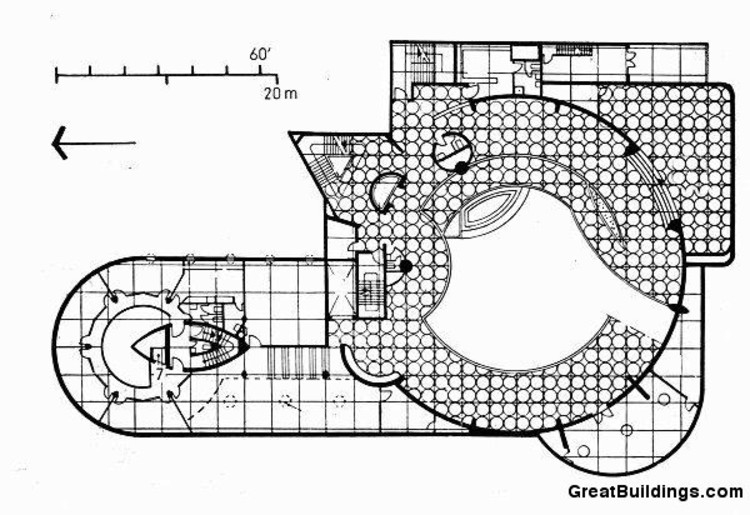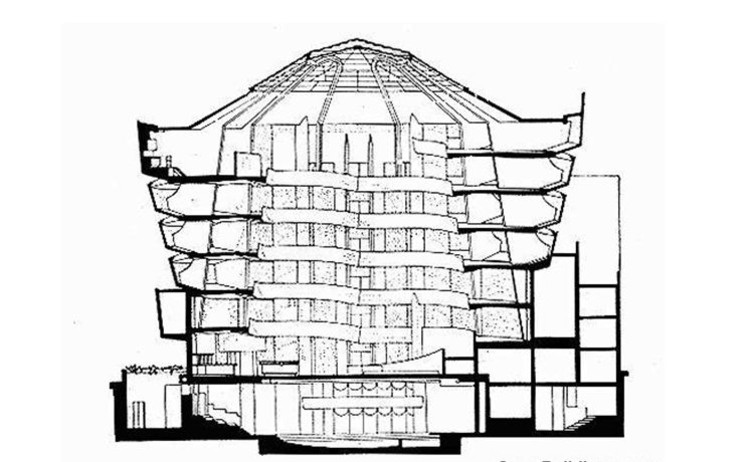AD Classics: Solomon R. Guggenheim Museum / Frank Lloyd Wright

- Written by Adelyn Perez
-
Facebook
-
Twitter
-
Pinterest
-
Whatsapp
-
Mail




 + 10
+ 10
-
Architects: Frank Lloyd Wright
- Year Completion year of this architecture project Year: 1959
Text description provided by the architects. Swelling out towards the city of Manhattan, the Solomon R. Guggenheim Museum was the last major project designed and built by Frank Lloyd Wright between 1943 until it opened to the public in 1959, six months after his death, making it one of his longest works in creation along with one of his most popular projects. Completely contrasting the strict Manhattan city grid, the organic curves of the museum are a familiar landmark for both art lovers, visitors, and pedestrians alike.

The exterior of the Guggenheim Museum is a stacked white cylinder of reinfored concrete swirling towards the sky. The museum’s dramatic curves of the exterior, however, had an even more stunning effect on the interior. Inside Wright proposed “one great space on a continuous floor,” and his concept was a success.

中に入って最初に目に入るのは高さが92フィート、大きなガラスのドームに至る吹き抜け空間です。 このアトリウムの両脇には、6階建てで4分の1マイル以上にも及ぶスロープが連続し、ある階から別の階へと流れ込むようになっています。 また、このスロープは、壁面に展示されたアートを体験しながら、空に向かって上っていくような行列を作り出しています。

1 つのフロアが続き、各階が吹き抜けを見下ろすランプの設計により、異なる階層の人々の交流も可能になりました。 また、そのようなデザインは断面的にも優れています。

建物内の空間は紛れもなく荘厳で建物自体が記念物ですが、機能的には完全に成功してはいなかったと思います。 内部の湾曲した壁は、「画家のイーゼルのように」絵画を後方に傾ける必要があるように意図されていました。 そのため、開館前に21人のアーティストが、このような空間での作品展示について抗議の書簡に署名した。

多くの評論家は、この建物が展示する予定の美術品と競合しているとも主張しており、この問題を博物館長のジェームズ・ジョンスイーンは真剣に受け止め「これは建築的にこの国で最も壮麗な博物館の内部だ」と述べています。 しかし、私の仕事は壮大なコレクションを最大限に見せることだ」と語っている。 また、ライトは、マンハッタンの建築基準監督官と構造上の問題で論争し、ガラスのドームを縮小し、外壁の目立たない構造柱の延長であるコンクリートのリブを含むように設計し直さなければならなかったことも問題でした。

1992年に美術館は、グワスマイ・シーゲル& Associates Architects によって、ライトがもともと意図した設計で、増築を行いました。 建築家たちはライトのスケッチを分析し、彼のアイデアをもとに、美術品の展示に適した平らな壁を持つ10階建ての石灰岩の塔を作りました。

Guggenheim Museum は 2005 年から 2008 年にかけ、外観を改装し、元の表面の 11 回塗りを落とし、気候上の理由から多くの亀裂を明らかにしました。 この発見は、外装の修復だけでなく、潜在的な補修材料をテストするための大規模な研究へとつながったのです。

評論家の意見もありますが、ライトのグッゲンハイム美術館への設計では彼のスタイルならではの空間の自由があることは間違いないでしょう。 700枚のスケッチと6枚の設計図によって、セントラルパークを見下ろす彫刻のような建物は、少なくとも国際建築の中で最も空間的に美しい作品の一つとして認められるべきものでしょう。

This building is part of our Architecture City Guide: New York. Check all the other buildings on this guide right here.